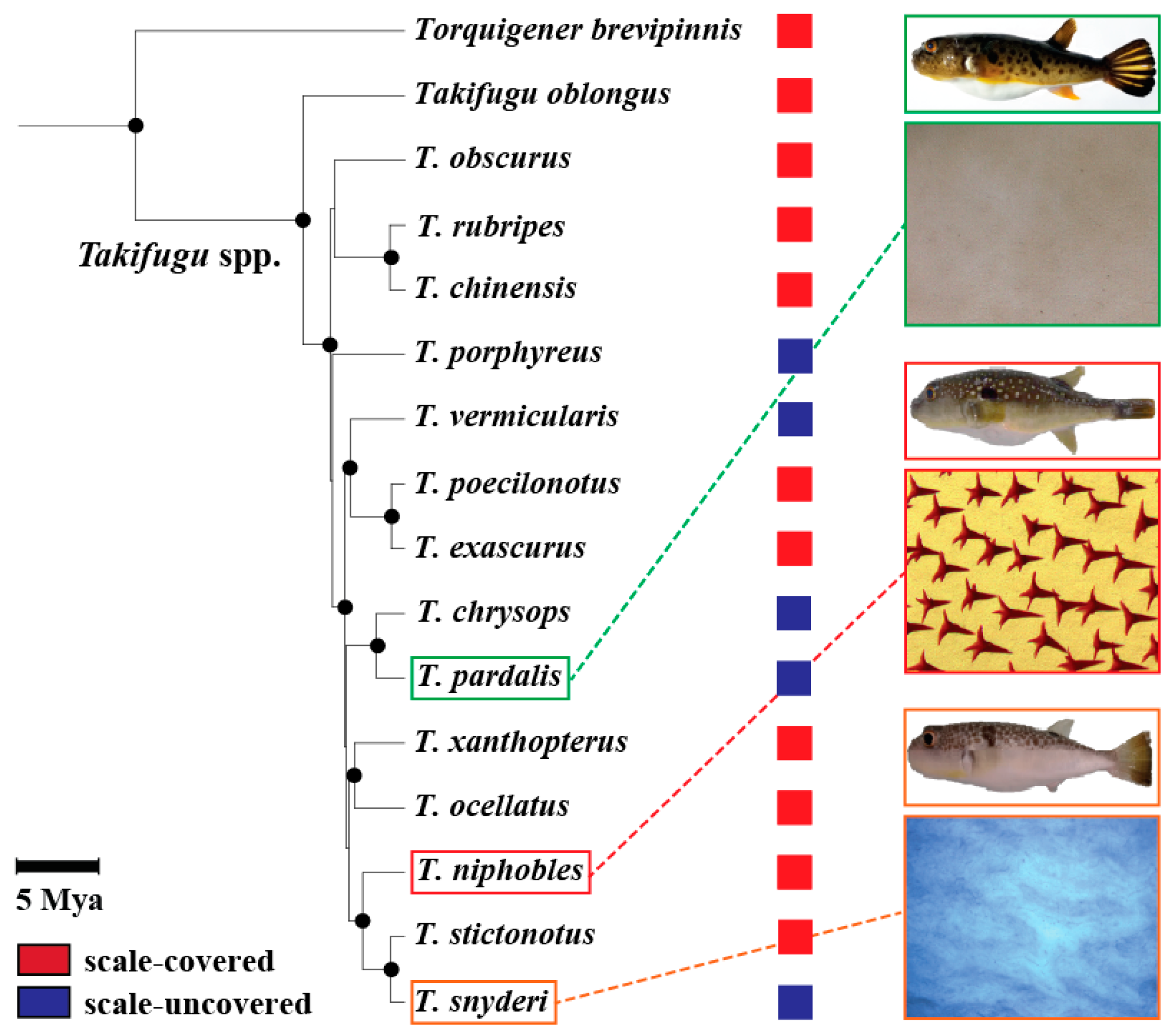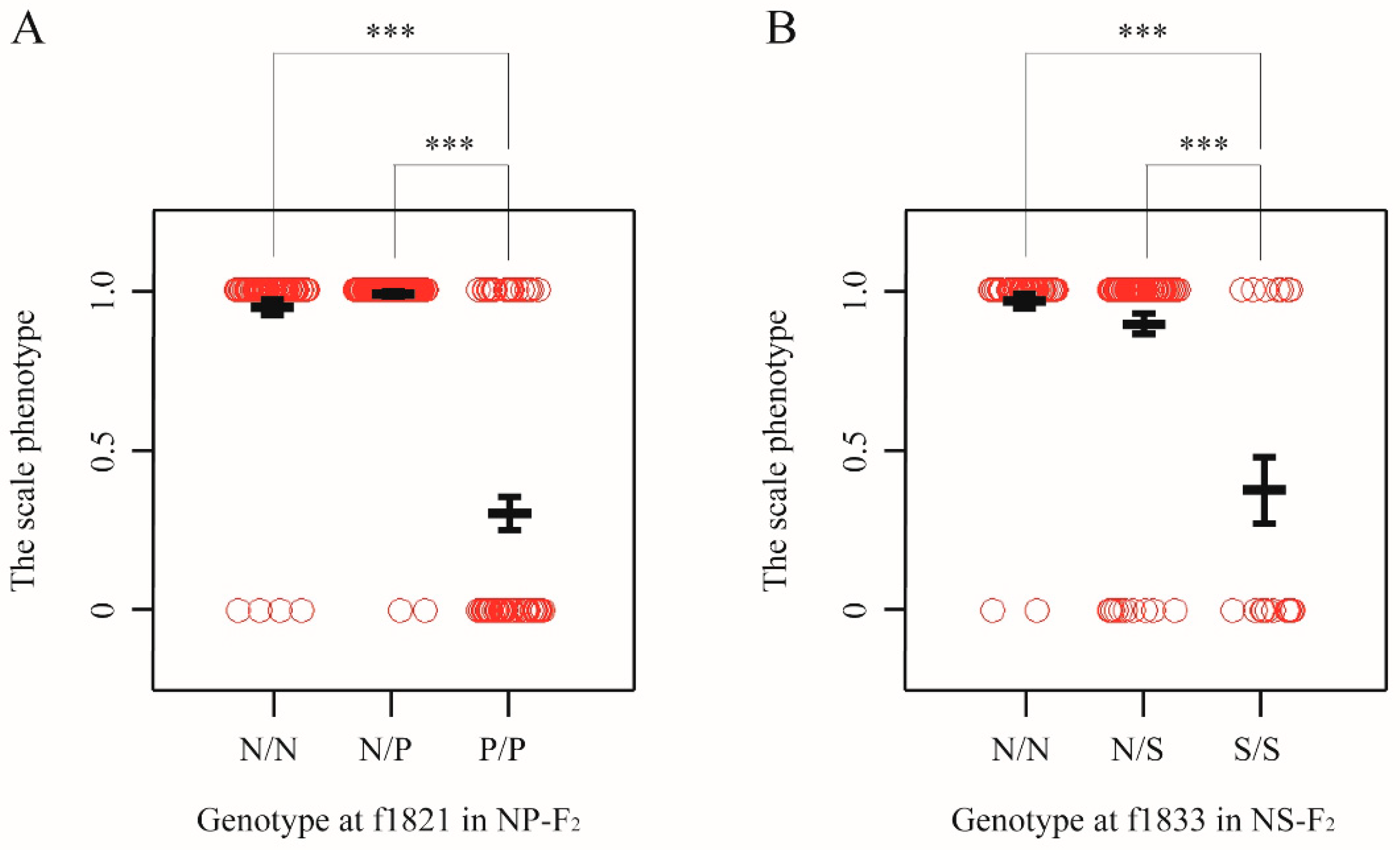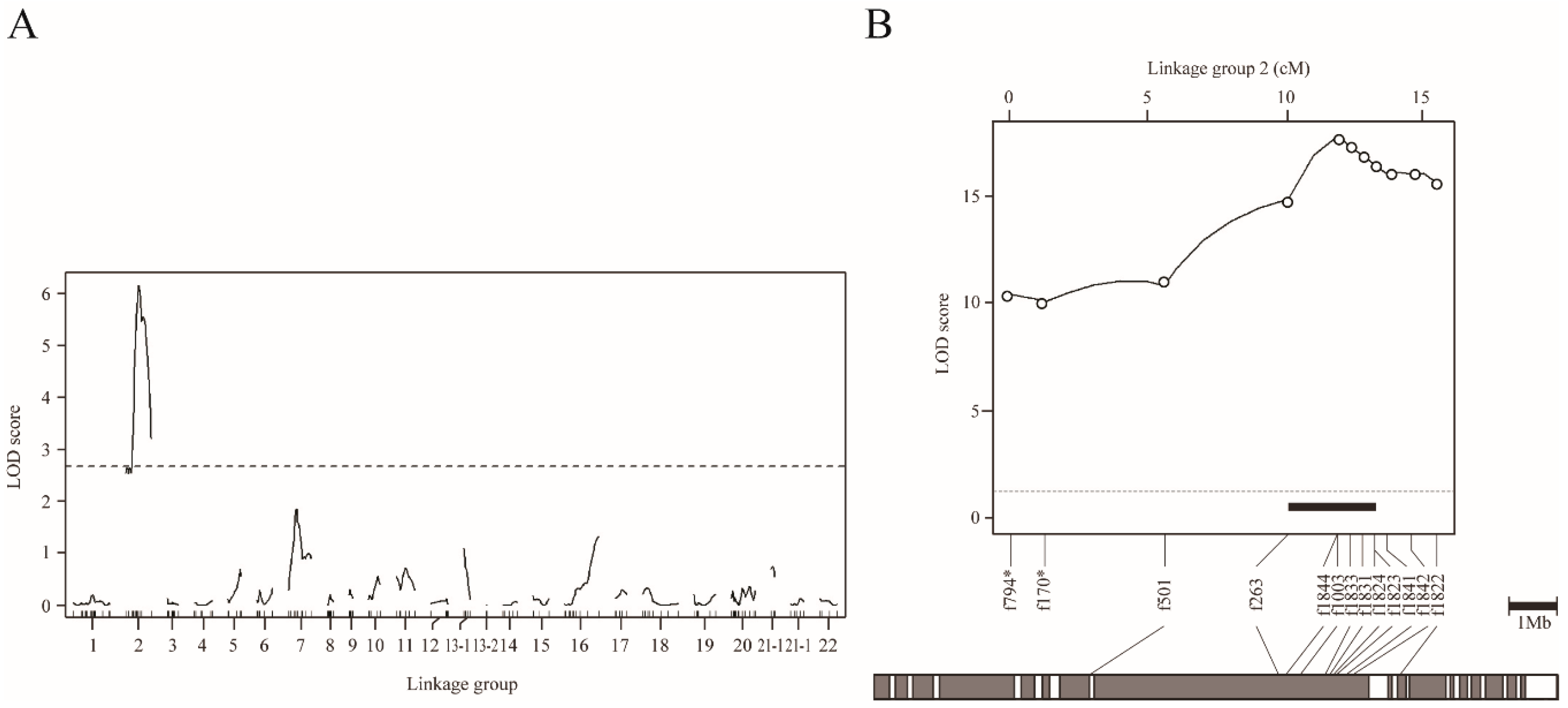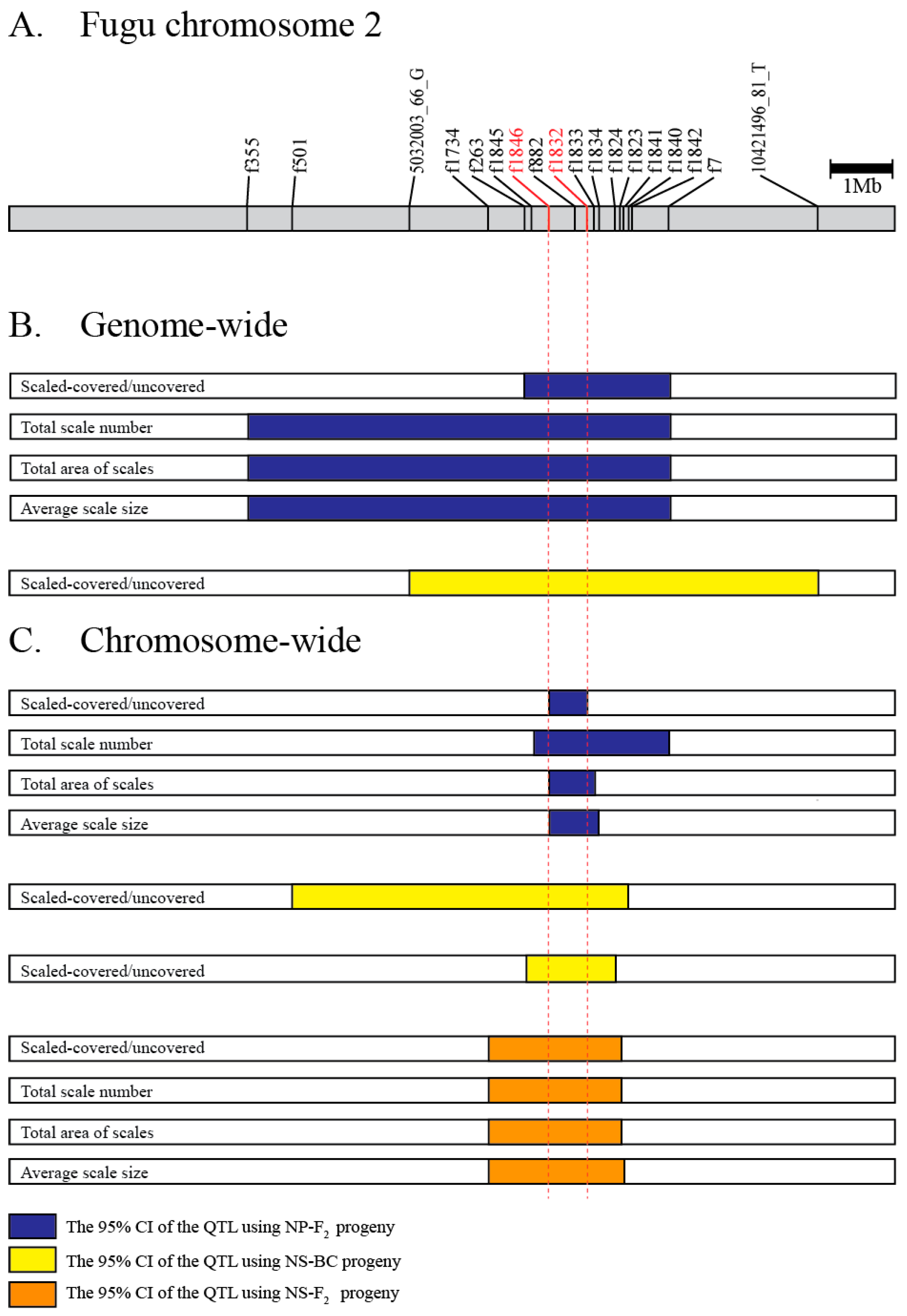The Genetic Basis of Scale-Loss Phenotype in the Rapid Radiation of Takifugu Fishes
Abstract
:1. Introduction
2. Materials and Methods
2.1. Developmental Pattern of Spiny Scales
2.2. Hybrid Crosses
2.3. Phenotyping
2.4. Genotyping
2.5. Linkage Map Construction and QTL Mapping
2.6. Complementation Test
2.7. Candidate Gene Search
2.8. Candidate Gene Mapping
2.9. Ethics and Data Availability
3. Results
3.1. Developmental Pattern of Spiny Scales
3.2. QTL Analysis
3.2.1. Linkage Map
3.2.2. Phenotypic Values
3.2.3. Genetic Basis of Scale Loss in T. Pardalis
3.2.4. Genetic Basis of Scale Loss in T. snyderi
3.2.5. Comparison of QTL Regions
3.3. Complementation Test
3.4. Candidate Gene Search
3.5. Candidate Gene Mapping
4. Discussion
5. Conclusions
Supplementary Materials
Author Contributions
Funding
Acknowledgments
Conflicts of Interest
References
- Berner, D.; Salzburger, W. The genomics of organismal diversification illuminated by adaptive radiations. Trends Genet. 2015, 31, 491–499. [Google Scholar] [CrossRef] [PubMed]
- Lamichhaney, S.; Berglund, J.; Almén, M.S.; Maqbool, K.; Grabherr, M.; Martinez-Barrio, A.; Promerová, M.; Rubin, C.; Wang, C.; Zamani, N. Evolution of Darwin’s finches and their beaks revealed by genome sequencing. Nature 2015, 518, 371. [Google Scholar] [CrossRef] [PubMed]
- Baldwin, B.G. Adaptive radiation of the hawaiian silversword alliance: Congruence and conflict of phylogenetic evidence from molecular and non-molecular investigations. Mol. Evol. Adapt. Radiat. 1997, 103, 1840–1843. [Google Scholar]
- Mahler, D.L.; Ingram, T.; Revell, L.J.; Losos, J.B. Exceptional convergence on the macroevolutionary landscape in island lizard radiations. Science 2013, 341, 292–295. [Google Scholar] [CrossRef] [PubMed]
- Colosimo, P.F.; Hosemann, K.E.; Balabhadra, S.; Villarreal, G.J.; Dickson, M.; Grimwood, J.; Schmutz, J.; Myers, R.M.; Schluter, D.; Kingsley, D.M. Widespread parallel evolution in sticklebacks by repeated fixation ectodysplasin-A of ectodysplasin alleles. Science 2005, 307, 1928–1933. [Google Scholar] [CrossRef] [PubMed] [Green Version]
- Loh, Y.E.; Bezault, E.; Muenzel, F.M.; Roberts, R.B.; Swofford, R.; Barluenga, M.; Kidd, C.E.; Howe, A.E.; Di Palma, F.; Lindblad-Toh, K. Origins of shared genetic variation in African cichlids. Mol. Biol. Evol. 2012, 30, 906–917. [Google Scholar] [CrossRef] [Green Version]
- Bendif, E.M.; Nevado, B.; Wong, E.L.; Hagino, K.; Probert, I.; Young, J.R.; Rickaby, R.E.; Filatov, D.A. Repeated Species radiations in the recent evolution of the key marine phytoplankton lineage Gephyrocapsa. Nat. Commun. 2019, 10, 1–9. [Google Scholar] [CrossRef] [Green Version]
- Nevado, B.; Atchison, G.W.; Hughes, C.E.; Filatov, D.A. Widespread adaptive evolution during repeated evolutionary radiations in new world lupins. Nat. Commun. 2016, 7, 12384. [Google Scholar] [CrossRef] [Green Version]
- Conte, G.L.; Arnegard, M.E.; Peichel, C.L.; Schluter, D. The Probability of genetic parallelism and convergence in natural populations. Proc. Biol. Sci. 2012, 279, 5039–5047. [Google Scholar] [CrossRef]
- Ellegren, H.; Sheldon, B.C. Genetic basis of fitness differences in natural populations. Nature 2008, 452, 169–175. [Google Scholar] [CrossRef]
- Elmer, K.R.; Meyer, A. Adaptation in the age of ecological genomics: Insights from parallelism and convergence. Trends Ecol. Evol. 2011, 26, 298–306. [Google Scholar] [CrossRef] [PubMed] [Green Version]
- Stern, D.L.; Orgogozo, V. The loci of evolution: how predictable is genetic evolution? Evolution 2008, 62, 2155–2177. [Google Scholar] [CrossRef] [PubMed] [Green Version]
- Streelman, J.; Peichel, C.L.; Parichy, D. Developmental genetics of adaptation in fishes: The case for novelty. Annu. Rev. Ecol. Evol. Syst. 2007, 38, 655–681. [Google Scholar] [CrossRef] [Green Version]
- Albertson, R.C.; Kawasaki, K.C.; Tetrault, E.R.; Powder, K.E. Genetic analyses in lake malawi cichlids identify new roles for fgf signaling in scale shape variation. Commun. Biol. 2018, 1, 55. [Google Scholar] [CrossRef] [PubMed]
- Aman, A.J.; Fulbright, A.N.; Parichy, D.M. Wnt/β-Catenin regulates an ancient signaling network during zebrafish scale development. Elife 2018, 7, e37001. [Google Scholar] [CrossRef] [PubMed]
- Shono, T.; Thiery, A.P.; Cooper, R.L.; Kurokawa, D.; Britz, R.; Okabe, M.; Fraser, G.J. Evolution and developmental diversity of skin spines in pufferfishes. iScience 2019, 19, 1248–1259. [Google Scholar] [CrossRef] [Green Version]
- Colosimo, P.F.; Peichel, C.L.; Nereng, K.; Blackman, B.K.; Shapiro, M.D.; Schluter, D.; Kingsley, D.M. The genetic architecture of parallel armor plate reduction in threespine sticklebacks. PLoS Biol. 2004, 2, e109. [Google Scholar] [CrossRef]
- Gosline, W.A. Mode of life, functional morphology, and the classification of modern teleostean fishes. Syst. Zool. 1959, 8, 160–164. [Google Scholar] [CrossRef]
- Harris, M. Comparative genetics of postembryonic development as a means to understand evolutionary change. J. Appl. Ichthyol. 2012, 28, 306–315. [Google Scholar] [CrossRef]
- Liu, Z.; Liu, S.; Yao, J.; Bao, L.; Zhang, J.; Li, Y.; Jiang, C.; Sun, L.; Wang, R.; Zhang, Y. The channel catfish genome sequence provides insights into the evolution of scale formation in teleosts. Nat. Commun. 2016, 7, 11757. [Google Scholar] [CrossRef]
- Nelson, J. Fishes of the World, 4th ed.; John Wiley and Sons Ltd: Hoboken, NJ, USA, 2006. [Google Scholar]
- Rohner, N.; Bercsényi, M.; Orbán, L.; Kolanczyk, M.E.; Linke, D.; Brand, M.; Nüsslein-Volhard, C.; Harris, M.P. Duplication of Fgfr1 permits Fgf signaling to serve as a target for selection during domestication. Curr. Biol. 2009, 19, 1642–1647. [Google Scholar] [CrossRef] [PubMed] [Green Version]
- Smith, D. Order anguilliformes anguillidae. In The Living Marine Resources of the Western Central Pacific; Food and Aquaculture Oranization of the Unitied Nations: Rome, Italy, 1998; p. 1630. [Google Scholar]
- Bell, M.A.; Gangavalli, A.K.; Bewick, A.; Aguirre, W.E. Frequency of ectodysplasin alleles and limited introgression between sympatric threespine stickleback populations. Environ. Biol. Fishes 2010, 89, 189–198. [Google Scholar] [CrossRef]
- Kondo, S.; Kuwahara, Y.; Kondo, M.; Naruse, K.; Mitani, H.; Wakamatsu, Y.; Ozato, K.; Asakawa, S.; Shimizu, N.; Shima, A. The medaka Rs-3 locus required for scale development encodes receptor. Curr. Biol. 2001, 11, 1202–1206. [Google Scholar] [CrossRef] [Green Version]
- Santini, F.; Nguyen, M.; Sorenson, L.; Waltzek, T.; Lynch Alfaro, J.; Eastman, J.; Alfaro, M. Do habitat shifts drive diversification in teleost fishes? an example from the pufferfishes (tetraodontidae). J. Evol. Biol. 2013, 26, 1003–1018. [Google Scholar] [CrossRef] [PubMed]
- Yamanoue, Y.; Miya, M.; Doi, H.; Mabuchi, K.; Sakai, H.; Nishida, M. multiple invasions into freshwater by pufferfishes (teleostei: tetraodontidae): A mitogenomic perspective. PLoS ONE 2011, 6, e17410. [Google Scholar] [CrossRef] [Green Version]
- Fujita, S. Studies on life history and aquaculture of japanese puffer fishes. Rep. Nagasaki. Pref. Inst. Fish 1962, 2, 1–121. [Google Scholar]
- Yamanoue, Y.; Miya, M.; Matsuura, K.; Miyazawa, S.; Tsukamoto, N.; Doi, H.; Takahashi, H.; Mabuchi, K.; Nishida, M.; Sakai, H. Explosive speciation of takifugu: another use of fugu as a model system for evolutionary biology. Mol. Biol. Evol. 2008, 26, 623–629. [Google Scholar] [CrossRef]
- Hosoya, S.; Kai, W.; Fujita, M.; Miyaki, K.; Suetake, H.; Suzuki, Y.; Kikuchi, K. The genetic architecture of growth rate in juvenile takifugu species. Evolution 2013, 67, 590–598. [Google Scholar] [CrossRef]
- Hosoya, S.; Suetake, H.; Suzuki, Y.; Kikuchi, K. Genetic basis underlying behavioral correlation between fugu takifugu rubripes and a closely related species, takifugu niphobles. Behav. Genet. 2015, 45, 560–572. [Google Scholar] [CrossRef]
- Kikuchi, K.; Kai, W.; Hosokawa, A.; Mizuno, N.; Suetake, H.; Asahina, K.; Suzuki, Y. The sex-determining locus in the tiger pufferfish, takifugu rubripes. Genetics 2007, 175, 2039–2042. [Google Scholar] [CrossRef] [Green Version]
- Rasband, W. ImageJ; US National Institutes of Health: Bethesda, MD, USA, 1997–2006. World Wide Web; 2004. Available online: http://rsb.info.nih.gov/ij/ (accessed on 3 March 2017).
- Asahida, T.; Kobayashi, T.; Saitoh, K.; Nakayama, I. Tissue preservation and total DNA extraction form fish stored at ambient temperature using buffers containing high concentration of urea. Fish Sci. 1996, 62, 727–730. [Google Scholar] [CrossRef] [Green Version]
- Kai, W.; Kikuchi, K.; Fujita, M.; Suetake, H.; Fujiwara, A.; Yoshiura, Y.; Ototake, M.; Venkatesh, B.; Miyaki, K.; Suzuki, Y. A Genetic linkage map for the tiger pufferfish, takifugu rubripes. Genetics 2005, 171, 227–238. [Google Scholar] [CrossRef] [PubMed] [Green Version]
- Kai, W.; Kikuchi, K.; Tohari, S.; Chew, A.K.; Tay, A.; Fujiwara, A.; Hosoya, S.; Suetake, H.; Naruse, K.; Brenner, S.; et al. Integration of the genetic map and genome assembly of fugu facilitates insights into distinct features of genome evolution in teleosts and mammals. Genome Biol. Evol. 2011, 3, 424–442. [Google Scholar] [CrossRef] [PubMed] [Green Version]
- Sato, M.; Hosoya, S.; Yoshikawa, S.; Ohki, S.; Kobayashi, Y.; Itou, T.; Kikuchi, K. A highly flexible and repeatable genotyping method for aquaculture studies based on target amplicon sequencing using next-generation sequencing technology. Sci. Rep. 2019, 9, 6904. [Google Scholar] [CrossRef] [Green Version]
- Robinson, J.T.; Thorvaldsdóttir, H.; Winckler, W.; Guttman, M.; Lander, E.S.; Getz, G.; Mesirov, J.P. Integrative genomics viewer. Nat. Biotechnol. 2011, 29, 24. [Google Scholar] [CrossRef] [Green Version]
- Ieda, R.; Hosoya, S.; Tajima, S.; Atsumi, K.; Kamiya, T.; Nozawa, A.; Aoki, Y.; Tasumi, S.; Koyama, T.; Nakamura, O. Identification of the sex-determining locus in grass puffer (takifugu niphobles) provides evidence for sex-chromosome turnover in a subset of takifugu species. PLoS ONE 2018, 13, e0190635. [Google Scholar] [CrossRef] [Green Version]
- Broman, K.W.; Wu, H.; Sen, Ś.; Churchill, G.A. R/qtl: QTL mapping in experimental crosses. Bioinformatics 2003, 19, 889–890. [Google Scholar] [CrossRef] [Green Version]
- Hothorn, T.; Hornik, K.; Van De Wiel, M.A.; Zeileis, A. Implementing a class of permutation pests: The coin package. J. Stat. Softw. 2008, 28, 8. [Google Scholar] [CrossRef]
- DOE Joint Genome Institute. Available online: https://mycocosm.jgi.doe.gov/Takru4/Takru4.home.html (accessed on 18 March 2016).
- Harris, M.P.; Rohner, N.; Schwarz, H.; Perathoner, S.; Konstantinidis, P.; Nüsslein-Volhard, C. Zebrafish eda and edar mutants reveal conserved and ancestral roles of ectodysplasin signaling in vertebrates. PLoS Genet 2008, 4, e1000206. [Google Scholar] [CrossRef] [Green Version]
- Byeon, M.; Park, J.; Yoon, S.; Kang, H. Structure and development of spines over the skin surface of the river puffer takifugu obscurus (tetraodontidae, teleostei) during larval growth. J. Appl. Ichthyol. 2011, 27, 67–72. [Google Scholar] [CrossRef]
- Hertwig, I.; Eichelberg, H.; Hentschel, J. Light and electron microscopic studies of the skin of the palembang puffer, tetraodon steindachneri (teleostei, tetraodontidae). Zoomorphology 1992, 111, 193–205. [Google Scholar] [CrossRef]
- Frankel, N.; Erezyilmaz, D.F.; McGregor, A.P.; Wang, S.; Payre, F.; Stern, D.L. Morphological evolution caused by many subtle-effect substitutions in regulatory DNA. Nature 2011, 474, 598. [Google Scholar] [CrossRef] [PubMed] [Green Version]
- Espinasa, L.; Robinson, J.; Espinasa, M. Mc1r gene in astroblepus pholeter and astyanax mexicanus: Convergent regressive evolution of pigmentation across cavefish species. Dev. Biol. 2018, 441, 305–310. [Google Scholar] [CrossRef] [PubMed]
- Gompel, N.; Prud’homme, B. The causes of repeated genetic evolution. Dev. Biol. 2009, 332, 36–47. [Google Scholar] [CrossRef] [Green Version]
- Christin, P.; Weinreich, D.M.; Besnard, G. Causes and evolutionary significance of genetic convergence. Trends Genet. 2010, 26, 400–405. [Google Scholar] [CrossRef]
- Stern, D.L. The genetic causes of convergent evolution. Nat. Rev. Genet. 2013, 14, 751. [Google Scholar] [CrossRef]
- Martin, A.; Orgogozo, V. The loci of repeated evolution: A catalog of genetic hotspots of phenotypic variation. Evolution 2013, 67, 1235–1250. [Google Scholar] [CrossRef]
- Brawand, D.; Wagner, C.E.; Li, Y.I.; Malinsky, M.; Keller, I.; Fan, S.; Simakov, O.; Ng, A.Y.; Lim, Z.W.; Bezault, E. The genomic substrate for adaptive radiation in african cichlid fish. Nature 2014, 513, 375. [Google Scholar] [CrossRef] [Green Version]
- Stankowski, S.; Chase, M.A.; Fuiten, A.M.; Ralph, P.L.; Streisfeld, M.A. The tempo of linked selection: emergence of a heterogeneous genomic landscape during a recent radiation of monkeyflowers. Biorxiv 2018. [Google Scholar] [CrossRef] [Green Version]
- Masuda, Y.; Shinohara, N.; Takahashi, Y.; Tabeta, O.; Matsuura, K. Occurrence of natural hybrid between pufferfishes, takifugu xanthopterus and t. vermicularis, in Ariake Bay, Kyushu, Japan. Nippon Suisan Gakk 1991, 57, 1247–1255. [Google Scholar] [CrossRef] [Green Version]
- Yokogawa, K.; Urayama, K. Natural hybrids between two species of puffer, Takifugu vermicularis and T. poecilonotus, obtained from the Seto inland Sea. Jpn. J. Ichthyol. 2000, 47, 67–73. [Google Scholar]
- Takahashi, H.; Toyoda, A.; Yamazaki, T.; Narita, S.; Mashiko, T.; Yamazaki, Y. Asymmetric Hybridization and introgression between sibling species of the pufferfish Takifugu that have undergone explosive speciation. Mar. Biol. 2017, 164, 90. [Google Scholar] [CrossRef]
- Meier, J.I.; Marques, D.A.; Mwaiko, S.; Wagner, C.E.; Excoffier, L.; Seehausen, O. Ancient hybridization fuels rapid cichlid fish adaptive radiations. Nat. Commun. 2017, 8, 14363. [Google Scholar] [CrossRef] [PubMed] [Green Version]
- Pardo-Diaz, C.; Salazar, C.; Baxter, S.W.; Merot, C.; Figueiredo-Ready, W.; Joron, M.; McMillan, W.O.; Jiggins, C.D. Adaptive introgression across species boundaries in Heliconius butterflies. PLoS Genet. 2012, 8, e1002752. [Google Scholar] [CrossRef] [PubMed] [Green Version]
- Yan, M.; Li, Z.; Xiong, B.; Zhu, J. Effects of salinity on food intake, growth, and survival of pufferfish (Fugu Obscurus). J. Appl. Ichthyol. 2004, 20, 146–149. [Google Scholar] [CrossRef]
- Yang, Z.; Chen, Y. Induced ovulation in obscure puffer Takifugu obscurus by injections of LHRH-a. Aquacult. Int. 2004, 12, 215–223. [Google Scholar] [CrossRef]
- Masuda, H.; Amaoka, K.; Araga, C.; Uyeno, T.; Yoshino, T. The Fishes of the Japanese Archipelago, (Plates); Tokai University Press: Shinjuku Tokai Building, Tokyo, Japan, 1984. [Google Scholar]
- Nakabō, T. Fishes of Japan: With Pictorial Keys to the Species; Tokai University Press: Tokyo, Japan, 2002. [Google Scholar]
- Streicher, J.W.; Devitt, T.J.; Goldberg, C.S.; Malone, J.H.; Blackmon, H.; Fujita, M.K. Diversification and asymmetrical gene flow across time and space: Lineage sorting and hybridization in polytypic barking Frogs. Mol. Ecol. 2014, 23, 3273–3291. [Google Scholar] [CrossRef]
- Daane, J.M.; Rohner, N.; Konstantinidis, P.; Djuranovic, S.; Harris, M.P. Parallelism and epistasis in skeletal evolution identified through use of phylogenomic mapping strategies. Mol. Biol. Evol. 2015, 33, 162–173. [Google Scholar] [CrossRef] [Green Version]
- Hall, C.; Flores, M.V.; Murison, G.; Crosier, K.; Crosier, P. An essential role for zebrafish fgfrl1 during gill cartilage development. Mech. Dev. 2006, 123, 925–940. [Google Scholar] [CrossRef]
- Baertschi, S.; Zhuang, L.; Trueb, B. Mice with a targeted disruption of the fgfrl1 gene die at birth due to alterations in the diaphragm. FEBS J. 2007, 274, 6241–6253. [Google Scholar] [CrossRef]
- Gerber, S.D.; Steinberg, F.; Beyeler, M.; Villiger, P.M.; Trueb, B. The murine Fgfrl1 receptor is essential for the development of the metanephric kidney. Dev. Biol. 2009, 335, 106–119. [Google Scholar] [CrossRef] [PubMed] [Green Version]
- Gerber, S.D.; Amann, R.; Wyder, S.; Trueb, B. Comparison of the gene expression profiles from normal and Fgfrl1 deficient mouse kidneys reveals downstream targets of Fgfrl1 signaling. PLoS ONE 2012, 7, e33457. [Google Scholar] [CrossRef] [PubMed] [Green Version]
- Jalali, A.; Zhu, X.; Liu, C.; Nawshad, A. Induction of palate epithelial mesenchymal transition by transforming growth factor β3 signaling. Dev. Growth Differ. 2012, 54, 633–648. [Google Scholar] [CrossRef] [PubMed] [Green Version]
- Streisfeld, M.A.; Rausher, M.D. Population genetics, pleiotropy, and the preferential fixation of mutations during adaptive evolution. Evol. Int. J. Org. Evol. 2011, 65, 629–642. [Google Scholar] [CrossRef]







| Cross | Scale Phenotype | Day Post Hatch (dph) | Sample Number | LG | Pos (cM) | Marker | 95% CI (cM) a | LOD | P value | PVE (%) b | Add c | Dom d | ||
|---|---|---|---|---|---|---|---|---|---|---|---|---|---|---|
| A | ||||||||||||||
| NP-F2 | Covered/Uncovered | 104–122 | 109 | LG2 | 44.9 | f882 | 12.6 | 13.6 | 2.8 × 10−14 | 43.6 | − | − | ||
| Total number of scales | 45.0 | f882 | 30.6 | 8.3 | 7.9 × 10−10 | 31.9 | −5.8 | 3.6 | ||||||
| Total area of scales | 41.0 | f1003 | 30.6 | 9.0 | 5.8 × 10−12 | 37.8 | −7.5 | 2.7 | ||||||
| The size of scales | 41.0 | f1003 | 30.6 | 8.7 | 1.5 × 10−7 | 25.6 | −5.7 | 1.9 | ||||||
| NS-BC | Covered/Uncovered | 42 | 87 | 20.0 | 7222201_17 | 24.4 | 6.1 | 1.4 × 10−7 | 27.8 | − | − | |||
| B | ||||||||||||||
| NP-F2 | Covered/Uncovered | 149 | 358 | LG2 | 32.5 | f1821 | 1.8 | 37.0 | 0.00 | 37.9 | − | − | ||
| Total number of scales | 35.0 | f1823 | 11.3 | 9.57 | 1.4 × 10−9 | 10.8 | −4.9 | 4.3 | ||||||
| Total area of scales | 31.0 | f1846 | 2.0 | 22.9 | 0.00 | 32.5 | −11.0 | 7.5 | ||||||
| The size of scales | 31.0 | f1846 | 2.4 | 25.3 | 0.00 | 25.4 | −9.5 | 5.9 | ||||||
| NS-BC | Covered/Uncovered | 42 | 203 | 15.1 | f263 | 13.7 | 13.2 | 7.3 × 10−15 | 25.8 | − | − | |||
| 110 | 222 | 11.9 | f1003 | 3.2 | 17.8 | 0.00 | 30.8 | − | − | |||||
| NS-F2 | Covered/Uncovered | 109–110 | 196 | 38.0 | f1833 | 14.1 | 8.4 | 6.3 × 10−9 | 17.5 | − | − | |||
| Total number of scales | 43.0 | f1831 | 14.1 | 5.1 | 1.0 × 10−7 | 15.1 | −5.7 | 3.7 | ||||||
| Total area of scales | 38.0 | f1833 | 14.1 | 5.9 | 2.4 × 10−7 | 14.4 | −5.6 | 3.3 | ||||||
| The size of scales | 38.0 | f1833 | 14.7 | 5.1 | 1.5 × 10−4 | 8.6 | −4.0 | 3.0 | ||||||
| Gene Name | Position on fr3/FUGUv3 | Marker Designing Region | Mapped Chromosomes | ||
|---|---|---|---|---|---|
| Chr | Start (bp) | End (bp) | |||
| Eda | 14 | 5,873,023 | 5,884,580 | <500 bp downstream | 14 |
| Edar | 1 | 17,694,260 | 17,710,622 | intron 1 | 1 |
| Fgfr1a | 21 | 5,867,819 | 5,885,613 | <1 kb downstream | 21 |
| Fgfr1b | 6 | 6,749,205 | 6,758,778 | <5 kb downstream | 6 |
© 2019 by the authors. Licensee MDPI, Basel, Switzerland. This article is an open access article distributed under the terms and conditions of the Creative Commons Attribution (CC BY) license (http://creativecommons.org/licenses/by/4.0/).
Share and Cite
Kim, D.I.; Kai, W.; Hosoya, S.; Sato, M.; Nozawa, A.; Kuroyanagi, M.; Jo, Y.; Tasumi, S.; Suetake, H.; Suzuki, Y.; et al. The Genetic Basis of Scale-Loss Phenotype in the Rapid Radiation of Takifugu Fishes. Genes 2019, 10, 1027. https://doi.org/10.3390/genes10121027
Kim DI, Kai W, Hosoya S, Sato M, Nozawa A, Kuroyanagi M, Jo Y, Tasumi S, Suetake H, Suzuki Y, et al. The Genetic Basis of Scale-Loss Phenotype in the Rapid Radiation of Takifugu Fishes. Genes. 2019; 10(12):1027. https://doi.org/10.3390/genes10121027
Chicago/Turabian StyleKim, Dong In, Wataru Kai, Sho Hosoya, Mana Sato, Aoi Nozawa, Miwa Kuroyanagi, Yuka Jo, Satoshi Tasumi, Hiroaki Suetake, Yuzuru Suzuki, and et al. 2019. "The Genetic Basis of Scale-Loss Phenotype in the Rapid Radiation of Takifugu Fishes" Genes 10, no. 12: 1027. https://doi.org/10.3390/genes10121027




